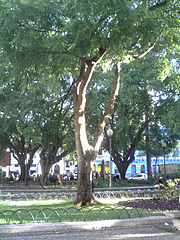People think gold is precious. It isn’t. You just go to the store and ask for it. The stick is a different story. You’d go to the ends of the earth and crawl on hands and knees to get that stick. – Charles Espey, bowmaker
 For over 250 years, pernambuco wood – harvested from the Pau-brasil tree in Brazil – has been the material used in constructing an overwhelming majority of bows for string instruments. While brazilwood, snakewood, and even some types of cherry have been used, the springiness, strength, and workability of pernambuco wood is unmatched by any other species of tree. This has not been a problem until recently, as it has become increasingly apparent that the Pau-brasil tree is rapidly becoming endangered. The tree grows only in very select portions of Brazil and only a very small portion of even the finest Pau-brasil trees possesses the qualities necessary to produce a fine bow.
For over 250 years, pernambuco wood – harvested from the Pau-brasil tree in Brazil – has been the material used in constructing an overwhelming majority of bows for string instruments. While brazilwood, snakewood, and even some types of cherry have been used, the springiness, strength, and workability of pernambuco wood is unmatched by any other species of tree. This has not been a problem until recently, as it has become increasingly apparent that the Pau-brasil tree is rapidly becoming endangered. The tree grows only in very select portions of Brazil and only a very small portion of even the finest Pau-brasil trees possesses the qualities necessary to produce a fine bow.
Consequently, in order to ensure the production of fine bows well into the future, several initiatives have been taken. The International Pernambuco Conservation Initiative (IPCI) was recently established in order to foster “research, replanting programs, educational outreach and other conservation measures.” Meanwhile, alternative materials are being sought after for use in bows. Chief among these is carbon fiber.
 Carbon fiber is a synthetic material that is both lightweight and super-strong. It consists of graphite fibers, thinner than human hair, which can be woven and molded into a permanent shape. Significant advances have been made in the science of carbon fiber over the past several decades. More and more bows (and instruments!) are being made from this material that meet or exceed some of their wooden counterparts.
Carbon fiber is a synthetic material that is both lightweight and super-strong. It consists of graphite fibers, thinner than human hair, which can be woven and molded into a permanent shape. Significant advances have been made in the science of carbon fiber over the past several decades. More and more bows (and instruments!) are being made from this material that meet or exceed some of their wooden counterparts.
Pernambuco and carbon fiber bows each have their own advantages. Pernambuco bows are hand crafted in a traditional fashion with centuries of experience influencing makers worldwide. A good pernambuco bow is delicately nuanced, and come from a long line of artistic excellence. But, due to the limitations of pernambuco wood, a fantastic wood bow could turn out to be much more expensive than a carbon fiber bow that has a similar level of playability.
 Carbon fiber, meanwhile, is incredibly stable. It won’t warp, it is difficult to break, and it won’t react very much to changes in temperature or humidity. This could make it a good choice for someone living in a humid climate or someone who does a lot of playing outdoors. Many players like to use a carbon fiber bow as a good second bow, one that can be used for extended col legno passages or outdoor gigs.
Carbon fiber, meanwhile, is incredibly stable. It won’t warp, it is difficult to break, and it won’t react very much to changes in temperature or humidity. This could make it a good choice for someone living in a humid climate or someone who does a lot of playing outdoors. Many players like to use a carbon fiber bow as a good second bow, one that can be used for extended col legno passages or outdoor gigs.
So, which material is best for you? If you are looking for a new bow, the most important thing to do is to try out several bows on your own instrument. Play a variety of repertoire and see how each bow responds. How do they handle long, sustained passages? Martele? Rapid spiccato? Each bow is as unique and individual as its player.
The preference between pernambuco and carbon fiber is ultimately up to you! Enjoy your bow trials and please – the next time you’re on vacation in Brazil – don’t take home the pernambuco logs as a souvenir.




